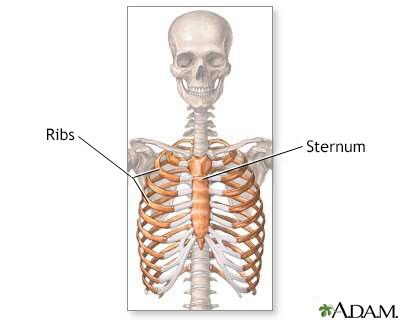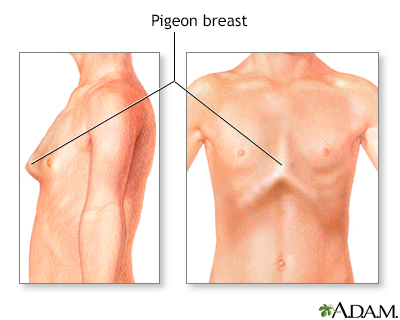Pectus carinatum
Definition
Pectus carinatum is present when the chest protrudes over the sternum. It is often described as giving the person a bird-like appearance.
Alternative Names
Pigeon breast; Pigeon chest
Considerations
Pectus carinatum may occur alone or along with other genetic disorders or syndromes. The condition causes the sternum to protrude. There is a narrow depression along the sides of the chest. This gives the chest a bowed-out appearance similar to that of a pigeon.
People with pectus carinatum generally develop a normal heart and lungs. However, the deformity may prevent these from functioning as well as they could. There is some evidence that pectus carinatum may prevent complete emptying of air from the lungs in children. These young people may have less stamina, even if they do not recognize it.
Pectus deformities can also have an impact on a child's self-image. Some children live happily with pectus carinatum. For others, the shape of the chest can damage their self-image and self-confidence. These feelings may interfere with forming connections to others.
Causes
Causes may include:
- Congenital pectus carinatum (present at birth)
- Trisomy 18
- Trisomy 21
- Homocystinuria
- Marfan syndrome
- Morquio syndrome
- Multiple lentigines syndrome
- Osteogenesis imperfecta
In many cases the cause is unknown.
Home Care
No specific home care is needed for this condition.
When to Contact a Medical Professional
Call your health care provider if you notice that your child's chest seems abnormal in shape.
What to Expect at Your Office Visit
The provider will perform a physical exam and ask questions about the child's medical history and symptoms. Questions may include:
- When did you first notice this? Was it present at birth, or did it develop as the child grew?
- Is it getting better, worse, or staying the same?
- What other symptoms are present?
Tests that may be done include:
- Lung function testing to measure how well the heart and lungs are performing
- Lab tests such as chromosome studies, enzyme assays, x-rays, or metabolic studies
A brace may be used to treat children and young adolescents. Surgery is sometimes done. Some people have gained improved exercise ability and better lung function after surgery.
Gallery


References
Boas SR. Skeletal diseases influencing pulmonary function. In: Kliegman RM, St. Geme JW, Blum NJ, Shah SS, Tasker RC, Wilson KM, eds. Nelson Textbook of Pediatrics. 21st ed. Philadelphia, PA: Elsevier; 2020:chap 445.
Gottlieb LJ, Reid RR, Slidell MB. Pediatric chest and trunk defects. In: Rodriguez ED, Losee JE, Neligan PC, eds. Plastic Surgery: Volume 3: Craniofacial, Head and Neck Surgery and Pediatric Plastic Surgery. 4th ed. Philadelphia, PA: Elsevier; 2018:chap 40.
Kelly RE, Martinez-Ferro M. Chest wall deformities. In: Holcomb GW, Murphy JP, St. Peter SD eds. Ashcraft's Pediatric Surgery. 7th ed. Philadelphia, PA: Elsevier; 2020:chap 20.
